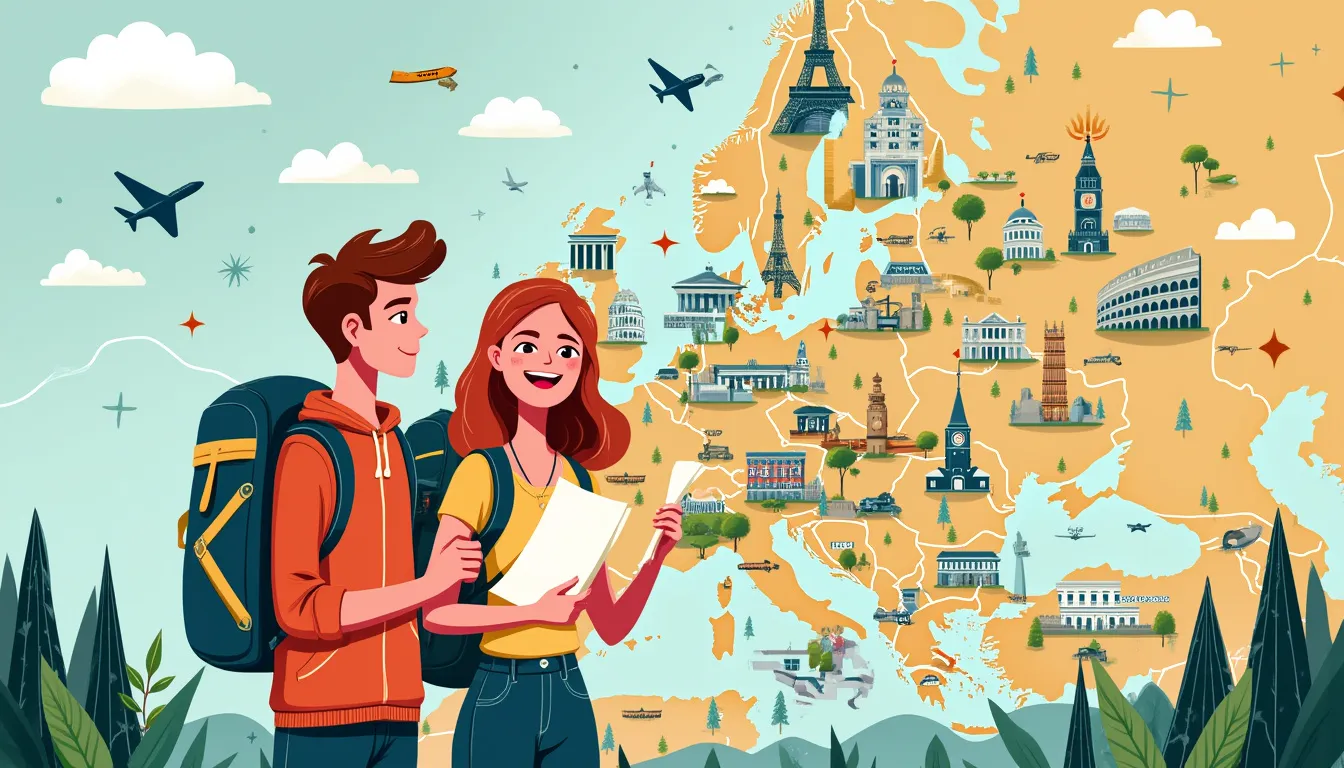Planning a two-week trip to Europe can seem daunting, but with the right approach, it can be an incredibly rewarding experience. When you know how to travel Europe for 2 weeks, you can make the most of every moment, soaking in a diverse array of cultures, landscapes, and historical landmarks. The key to a successful journey lies in meticulous planning and knowing how to optimize your time and budget.
To start, consider creating an itinerary that allows you to see a variety of iconic destinations without feeling rushed. This often involves selecting a mix of major cities and charming towns, and understanding the best routes and modes of transportation to maximize your time. Sample itineraries can offer a great starting point, showcasing popular travel routes that efficiently cover key highlights across Europe.
Equally important is managing your budget and packing wisely. With some practical strategies, it’s possible to enjoy Europe’s splendor without breaking the bank. Look for budget-friendly accommodation options, discover local eateries for authentic yet affordable meals, and take advantage of cost-effective transportation methods. Additionally, packing smartly can save you from unnecessary stress. Consider the essentials that you’ll need and adopt packing strategies that ensure you have everything on hand without overburdening yourself.
By following these tips on how to travel Europe for 2 weeks, you can anticipate a smooth, enjoyable adventure that will leave you with lasting memories.
Planning Your Itinerary: Essential Tips on How to Travel Europe for 2 Weeks
Maximize your time: Choosing the must-see destinations and optimizing travel routes
When considering how to travel Europe for 2 weeks, the key to an enjoyable and efficient trip lies in meticulous planning of your itinerary. Time is of the essence, and knowing which destinations to prioritize and the best travel routes can make a world of difference.
First, start by identifying your must-see destinations. Europe is brimming with iconic cities and awe-inspiring landscapes, so focusing on your personal interests is crucial. Are you drawn to the romantic allure of Paris, the historical richness of Rome, or the artistic charm of Barcelona? Make a list of the top cities or attractions you don’t want to miss.
Once you’ve highlighted your top destinations, it’s time to optimize your travel routes. Considering the vast and diverse landscape of Europe, efficient route planning can save you considerable travel time and reduce fatigue. Use tools like Google Maps and Rome2Rio to visualize your journey and calculate travel times between different points. A good rule of thumb is to focus on regions that are geographically close to each other to minimize long travel distances and maximize time spent exploring these cities.
Additionally, consider using Europe’s excellent high-speed train network. Trains such as the Eurostar, TGV, and ICE can whisk you from one city to another in just a few hours, often more comfortably and with less hassle than flying. For example, a train from Paris to Amsterdam takes about 3 hours compared to a 1-hour flight that can end up consuming your entire morning, once check-in, security, and travel to and from airports are factored in. Rail passes like the Eurail Global Pass offer flexibility and can be a cost-effective solution for longer journeys.
However, don’t completely dismiss budget airlines for stretches that seem impractical by train. Carriers like Ryanair and EasyJet offer affordable options, especially when booked in advance. Just remember to factor in baggage fees and the time needed to navigate airports.
Sample itineraries: Exploring popular two-week travel routes across Europe
To give you a head start, here are sample itineraries that you can tailor to suit your preferences. These itineraries are structured to give you a balanced mix of culture, history, and leisure, encapsulating the essence of how to travel Europe for 2 weeks.
Itinerary 1: Western Europe Highlights
– **Day 1-3: London, UK** – Begin your trip in London. Visit the British Museum, Buckingham Palace, and the Tower of London. Take your time to enjoy the vibrant culture in Covent Garden and the West End.
– **Day 4-6: Paris, France** – A Eurostar journey brings you to Paris. Explore the Eiffel Tower, Louvre Museum, and Notre-Dame Cathedral. Don’t forget to relax in a café with a view!
– **Day 7-9: Amsterdam, Netherlands** – Travel by high-speed Thalys train to Amsterdam. Visit the Anne Frank House, Van Gogh Museum, and take a canal tour.
– **Day 10-12: Berlin, Germany** – A short flight or train ride gets you to Berlin. Spend your days at the Berlin Wall, Brandenburg Gate, and Museum Island.
– **Day 13-14: Prague, Czech Republic** – End your trip in Prague. Wander through Old Town Square, visit Prague Castle, and enjoy the views from Charles Bridge.
Itinerary 2: Southern Europe Escape
– **Day 1-3: Rome, Italy** – Start in Rome. Explore the Colosseum, Vatican City, and the Roman Forum. Relish in authentic Italian cuisine.
– **Day 4-6: Florence, Italy** – Use the Trenitalia service to reach Florence. Marvel at the Duomo, Uffizi Gallery, and Ponte Vecchio. Don’t miss a day trip to Pisa.
– **Day 7-9: Barcelona, Spain** – Fly to Barcelona. Learn about Gaudi’s masterpieces like the Sagrada Familia, Park Güell, and La Rambla.
– **Day 10-12: Madrid, Spain** – A short flight or train ride takes you to Madrid. Explore the Royal Palace, Prado Museum, and Retiro Park.
– **Day 13-14: Lisbon, Portugal** – Conclude your journey in Lisbon. Visit the Jerónimos Monastery, Belém Tower, and take a tram ride through the narrow streets of Alfama.
Itinerary 3: Northern Europe Charm
– **Day 1-3: Copenhagen, Denmark** – Begin in Copenhagen. Explore Tivoli Gardens, Nyhavn Harbor, and the Little Mermaid statue.
– **Day 4-6: Stockholm, Sweden** – Take a short flight to Stockholm. Discover the Vasa Museum, Gamla Stan, and ABBA Museum.
– **Day 7-9: Oslo, Norway** – Travel by scenic train or a brief flight to Oslo. Visit the Viking Ship Museum, Vigeland Sculpture Park, and the Oslo Opera House.
– **Day 10-12: Helsinki, Finland** – Take the overnight ferry or a short flight to Helsinki. See the Market Square, Suomenlinna Fortress, and Uspenski Cathedral.
– **Day 13-14: Tallinn, Estonia** – A ferry or flight brings you to Tallinn. Stroll through the medieval Old Town, visit Toompea Castle, and enjoy the local cuisine.
Crafting the perfect itinerary requires a blend of strategic planning and personal preference. By selecting must-see destinations and optimizing your routes, you will make the most out of your two weeks in Europe, ensuring a memorable and enriching travel experience. Keep in mind, flexibility is also essential; embrace spontaneity when an unexpected opportunity or local recommendation arises.

Budgeting and Packing: Practical Advice for a Smooth 2-Week European Adventure
Budget-Friendly Tips: Saving Money on Accommodation, Food, and Transportation
Embarking on a two-week European journey can be financially daunting, but with some savvy planning, you can keep costs under control without sacrificing the quality of your experience. Here’s how to save money on accommodation, food, and transportation while exploring Europe:
Accommodation
Accommodation can be one of the most significant expenses when traveling. However, there are numerous ways to save on lodging:
- Book in Advance: Early bookings usually offer better rates, and you’ll have a wider selection of available accommodations. Many European cities have hotel deals and discounts several months in advance.
- Consider Alternative Accommodations: Hostels, budget hotels, vacation rentals (like Airbnb), and even dormitories can offer affordable lodging options. Hostels have made huge strides in comfort and amenities, often providing private rooms and modern facilities at a fraction of the cost of hotels.
- Stay Just Outside Major Cities: Staying in suburban areas or smaller towns outside major tourist hubs can save you substantial amounts on lodging. Europe has an excellent public transport system, making commuting to main attractions easy and cost-effective.
- Utilize Loyalty Programs: If you’re a frequent traveler, loyalty programs and reward points can help you save on accommodation costs.
- House Sitting or Couchsurfing: Websites like TrustedHousesitters or Couchsurfing offer unique, low-cost ways to find a place to stay while meeting locals and getting an authentic travel experience.
Food
Dining out for every meal can quickly eat into your travel budget. Here are some tips to enjoy local cuisine without overspending:
- Eat Like a Local: Seek out local markets, street food vendors, and casual cafes to enjoy delicious and affordable meals. Street food in Europe is often high quality and provides an authentic taste of the region.
- Cook Your Own Meals: If you’re staying at a place with a kitchen, take advantage of this by buying groceries and cooking some of your meals. Visiting local markets and grocery stores not only saves money but can be a cultural experience in itself.
- Lunch Specials: Many restaurants offer budget-friendly lunch specials or prix fixe menus that provide a full meal at a reduced price compared to dinner.
- Picnics: Purchase fresh bread, cheese, fruits, and other local foods to create a picnic. It’s a delightful and affordable way to enjoy a meal in European parks or by scenic spots.
- Tap Water: In many European countries, tap water is safe to drink. Bring a reusable water bottle to refill instead of buying bottled water.
Transportation
Efficient transportation can help you make the most of your two-week European adventure while keeping your budget intact:
- Use Budget Airlines: Europe is home to many low-cost carriers, such as Ryanair and EasyJet, offering budget-friendly flights between major cities. Booking in advance usually secures the best fares.
- Travel by Train: Europe’s extensive train network is both efficient and scenic. Consider purchasing a Eurail Pass or regional train passes if you plan to travel frequently by train—it can be a cost-effective way to cover large distances.
- Public Transportation: Public transit systems in most European cities are excellent and economical. Utilize buses, trams, subways, and bikes to navigate cities rather than taxis or rideshares.
- Walk: Walking is not only free but also a great way to immerse yourself in the local culture and discover hidden gems that you might miss when using other forms of transport.
- Car Rentals: If you plan to explore rural areas or smaller towns, renting a car can be affordable and offer flexibility. Carpooling options like BlaBlaCar may also be cost-efficient and provide opportunities to interact with locals.
- Booking Apps: Many apps and websites offer discounted travel fares and promotions. Use tools like Skyscanner, TravelSupermarket, and Rome2Rio to compare prices and book the best deals.
Packing Smart: Essential Items and Packing Strategies for a Hassle-Free Trip
Packing effectively is key to ensuring a smooth and stress-free two-week journey through Europe. Here are some essential tips to pack smart:
Travel Light
Packing light is essential for mobility and ease, especially when navigating European cities with public transport and cobblestone streets. Aim for a carry-on-sized bag and a backpack. Here’s how:
- Choose Versatile Clothing: Pack clothing items that mix and match easily. Neutral colors and multipurpose garments (like a scarf that can act as a shawl) are great choices.
- Layering: Weather can change quickly, and different regions in Europe may have varying climates. Layering allows you to adjust to temperature changes without packing bulky items.
- Limit Shoes: Bring two to three pairs of shoes, including a comfortable pair for walking, another for evenings or special occasions, and perhaps sandals or flip-flops for warmer areas.
Essential Items
Pack the following essentials to cover varying situations and ensure comfort:
- Travel Sized Toiletries: Opt for travel-sized toiletries to comply with airline regulations and save space. Many accommodations also provide basic toiletries.
- Electronics: Bring only necessary electronics (smartphone, camera, e-reader) and their chargers. Consider a universal adapter for varying plug types in different countries.
- Travel Documents: Keep your passport, visas (if applicable), travel insurance, accommodation confirmations, and transportation tickets organized and secure. Scanning copies of these documents and storing them digitally can be helpful.
Organize Efficiently
A well-organized suitcase can save time and reduce stress during your trip:
- Packing Cubes: These help to compartmentalize your belongings, making it easier to find items quickly and keep your suitcase organized.
- Compression Bags: Use compression bags to save space by compressing bulky clothing items like jackets or sweaters.
- Daypack: Carry a small backpack or daypack for daily excursions to hold essentials like water, snacks, maps, and a guidebook.
By planning your budget and packing smartly, you can set the foundation for a smooth and enjoyable two-week adventure across Europe. These strategies will not only help you save money but also ensure that you’re well-prepared for all the experiences that this beautiful continent has to offer.
Embarking on a two-week journey across Europe is both an exhilarating and enriching experience, demanding thoughtful planning and meticulous preparation. By focusing on crafting a well-balanced itinerary that includes essential destinations while optimizing travel routes, travelers can ensure they maximize their time exploring the continent. Sample itineraries offer valuable templates that cater to varied interests, enabling explorers to choose routes that resonate with their travel aspirations.
Equally important is the aspect of budgeting and packing, where strategic planning can significantly enhance the quality of the trip. Adopting budget-friendly practices such as selecting economical accommodation options, seeking out affordable yet authentic culinary experiences, and leveraging efficient transportation methods can contribute to a fulfilling yet cost-effective journey. A well-considered packing strategy, inclusive of essential items and tailored to the specific requirements of a European adventure, will further ensure a smooth and hassle-free travel experience.
In summary, successfully navigating a two-week European adventure hinges on effective itinerary planning, prudent budgeting, and smart packing. By adhering to these guidelines, travelers can look forward to an unforgettable expedition through some of the world’s most iconic destinations, all while maintaining comfort and financial efficiency.







